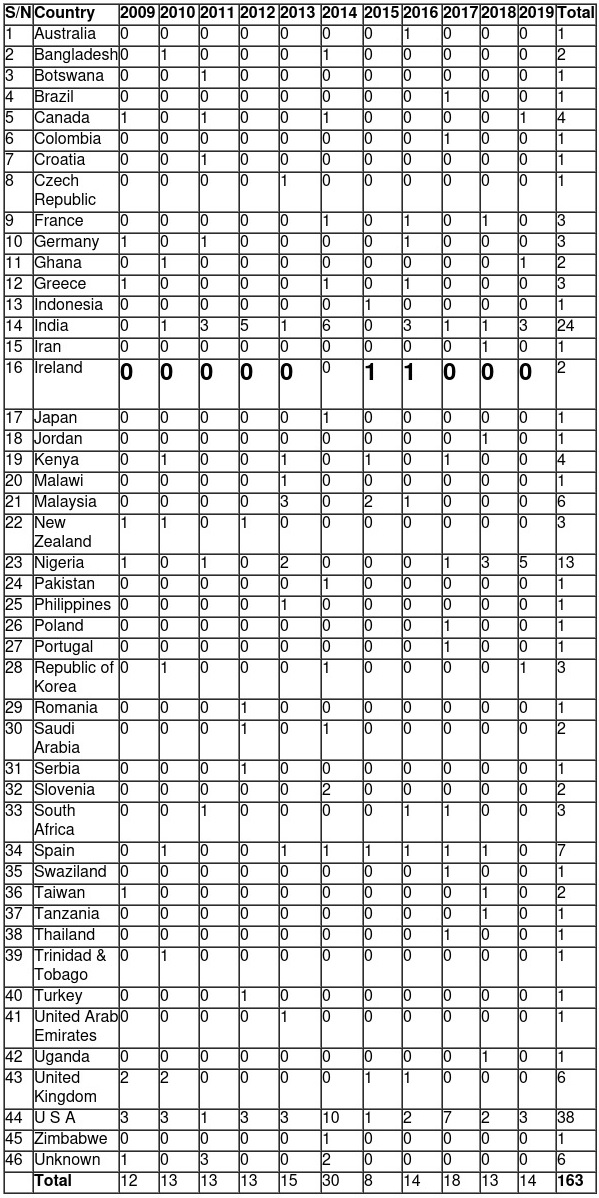
A BIBLIOMETRIC STUDY OF INSTITUTIONAL REPOSITORY PUBLICATIONS IN EMERALD ONLINE DATABASE: 2009-2019
Okeoma, Ezechukwu Chinelo
University Library, University of Uyo
Akwa Ibom State, Nigeria
Email: okeomaezechukwu@uniuyo.edu.ng
Jude-Iwuoha, Adaeze Ukamaka
University Library,
Michael Okpara University of Agriculture, UmudikeAbiaState
Email: adizy2003@yahoo.com
Abstract
Institutional repository is an offshoot of open access scholarly communication. The purpose of this study was to analyze studies on institutional repository in Emerald database. The analysis covered an approximately eleven-year period, from 2009 to 2019. It examined the Country-wise distribution of publications, institution-wise distribution of authors per publication, Year-wise distribution of publications,Category-wise distribution of publications, and; Authorship status and collaboration patterns of authors. Data was collected from Emerald Database as at November 29, 2019, using keyword search . A total of 154 publications on institutional repository were identified and analyzed.The study revealed that United States of America had the highest publication on institutional repository, while GERiiCO, University of Lille 3, Villeneuve d’Ascq, France was the most published institution. The Electronic Library took the lead as the highest journal with publications on institutional repository. Category type was majorly research reports. The year 2014 recorded the highest contributions on institutional repository as well as the highest multiple authorship. The findings also showed a high level of teamwork as more than half of the publications were jointly authored and three with as many as seven authors. The study highlights and gives empirical evidence on institutional repository publications available in the Emerald database.
Keywords: Institutional Repository, Library and Information Science, Bibliometric Analysis, Emerald Database.
Introduction
Academic and research institutions exist to carry out research for the continuous development of human knowledge. Unfortunately, some of these original research findings are not shared beyond the institution of origin. The print copies of such research findings sometimes remain on the library shelves, or the book shelves of the faculty, thus are largely underutilised. The need for preservation and accessibility of scholarship and scholarly communication among faculty and students of institution of higher learning gave rise to the development of Institutional Repositories (IRs).
Capturing this succinctly, ESRC Data Policy, cited in Bishop (2007) avers that institutional repositories are growing at a rapid rate driven by issues such as the need for institution to promote their intellectual capital, researchers’ seeking greater control over output dissemination, research councils and other funders requiring data to be offered for deposit, and the growing support for open access initiatives. Indeed, many research and educational institutions are finding the promises of creating and maintaining an institutional repository appealing, and in many cases libraries are intimately, often centrally, involved in this effort (Bluh&Hepfer, 2013).The institutional repository is established to collect, house, preserve and make accessible online, the intellectual output of a given research or educational institution. It also increases access to and expands the visibility of the institution’s scholarly output (Daniels, Jannik& McDonald, 2005).
A functional and online open access institutional repository provide interface for online submission of research publications, online access to the content (metadata and full pub), and share metadata with other institutional repositories. It thus enables the discoverability, maximise the availability and accessibility of publications of a given institution. This helps to increase the visibility of the institution and a subsequent increase on the usage and impact of the work of individual researchers. The content may generally include journal articles (pre-print and post prints), conference papers, working papers, postgraduate or doctoral thesis and dissertations, committee reports, inaugural lectures, and other kinds scholarly publications. Institutional repositories are expected to:
- Create global visibility for an institutions scholarly research.
- showcase, store and preserve scholarly output and historic documents
- collect content in a single location.
- provide access to institutional research output by self-archiving it.
- allow faculty to self-archive post-prints, preprints, and extra materials
- provide a stable environment for the preservation of born digital materials (Daniels, Jannik& McDonald, 2005; Md. Ashikuzzaman, 2018).
The importance of Institutional Repository thus necessitated this bibliometric study to create awareness on studies carried out in this important system. Bibliometrics is defined by the OECD Glossary of Statistical Terms (2013) as a statistical analysis of books, articles, or other publications. It is a field of study which deals with measurement of the process of scholarly publication of research achievements (Harinarayana, n.d). Bibliometric analysis can be used to systematically assess the relative importance of scientific research results in a certain area, and characterize the geographical distribution of the field (Xie, Ji, Zhang, & Huang, 2018). Bibliometric studies bring to the fore research and authorship trends in a given field of learning. Researches carried out in these institutions are made visible thus ensuring knowledge sharing, knowledge reuse and creation of new knowledge. Bibliometric analysis use data on numbers and authors of scientific publications and on articles and the citations therein (and in patents) to measure the “output” of individuals/research teams, institutions, and countries, to identify national and international networks, and to map the development of new (multi-disciplinary) fields of science and technology ( OECD Glossary of Statistical Terms, 2013).
The subject of Institutional repository was chosen due to its importance in encouraging open access to scholarly publishing in institutions of higher learning. Furthermore, this research was undertaken because, as noted by Bluh and Hepfer (2013), despite the abundance of information on institutional repositories, librarians consistently show an interest in learning more about their promises and pitfalls, and they seek practical advice on creating, maintaining, implementing, and marketing them.
Marshakova (cited in Gureev&Mazov, 2015) identified three main advantages of bibliometric analysis when compared to other methods, viz:
· Bibliometric analysis makes it possible to cover science in general.
· It is possible to use different methods of analysis based on the material of international bibliographic databases (DBs).
- In contrast to questionnaires, interviews, amongst others, in bibliometric analysis, the “reified phenomena” are the source material, when papers have already been published and cited.
Why Emerald?
Emerald is a reputable publishing firm in the United Kingdom. Emerald database is one of the prominent online databases for scholarly communications and publishing. Emerald is a scholarly publisher of journals and books in the area of economics and business management with growing coverage in the social sciences, engineering, education, Library and Information Science. It offers full text access to over 200 management journals and over 2000 books (Diaconu, 2019). Professor Craig Standing of the School of Management, Edith Cowan University, Australia avowed that Emerald is one of the most innovative and proactive academic publishers (www.emeraldgrouppublishing.com/products/collections/index.htm).
Need for the Study
Original research is made known through research publications. Research output in any field of study indicates the growth of knowledge in that field of study. This study is geared towards identifying research trends in the field; and provide an empirical research, which will help in evidence-based descriptions, comparisons, and visualization of research output in institutional repositories. It can also be used to explicate and describe the patterns of performance and impact of institutional repository research. The study focuses on institutional repository publications available in the Emerald database.
Objective of the Study:
The study intends to find out the:
1. Country-wise distribution of publications
2. Institution-wise distribution of authors per article
3. Year-wise distribution of publications
4. Category-wise distribution of publications
5. Journal-wise distribution of publications
6. Authorship status and collaboration patterns (Country and Institutional)
Method
Data was collected between October and November 2019. Publications were chosen beyond titles as the researchers took time to preview some works to determine the actual subject covered. The keyword search of Institutional Repository on Emerald database www.emeraldinsight.com was used to retrieve the data for the study. This was followed by a content search of the publications that popped up such that institutional repository publications with titles other than institutional repository were retrieved. A total of 154 articles were retrieved from the database published within the stipulated time frame.
Results
Table 1: Country-wise distribution of institutional repository publications in Emerald by year

Table 1 gives the country wise distribution of the institutional repository publications in Emerald database. United States of America had the highest publications with 38 articles, followed by India with 24 articles and Nigeria with 13 articles. Spain took the fourth position with 7 publications while Malaysia and UK had 6 respectively. Twenty-five countries made up of Australia, Botswana, Brazil,Colombia, Croatia, Czech Republic, Indonesia, Iran,Japan, Jordan, Malawi, Pakistan, Philippines, Poland, Portugal, Romania, Serbia, Swaziland, Tanzania, Thailand, Trinidad & Tobago, Turkey, United Arab Emirates, Uganda, andZimbabwe, had the least publication with one article each. There were 6 authors with countries unknown.
Table 2: Institution wise distribution of institutional repository publications

Table 2 indicates the institution-wise distribution of articles. Contributors of the institutional repository publications spread across 166 institutions, although the institutional affiliation of 6 authors was unknown. Some articles had up to three institutions due to joint authorship across institutions and countries.
Table 3: Most published institutions of institutional repository publications in Emerald
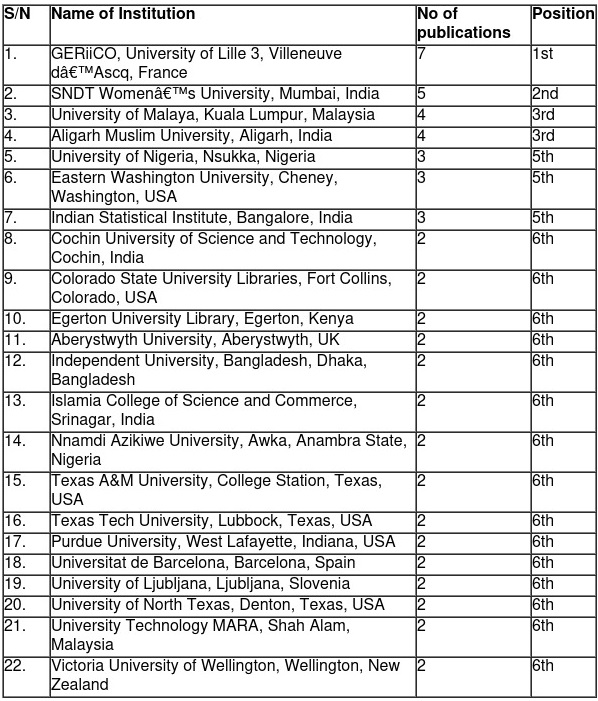
Table 3 shows the top six most published institutions. These institutions are 22 altogether with GERiiCO, University of Lille 3, Villeneuve d’Ascq, France taking the first position with 7 publications. SNDT Women’s University, Mumbai, India came second with 5 publications, while University of Malaya, Kuala Lumpur, Malaysia and Aligarh Muslim University, Aligarh, India came third with four publications each. Three institutions (University of Nigeria, Nsukka, Nigeria; Eastern Washington University, Cheney, Washington, USA; and Indian Statistical Institute, Bangalore, India) took the 5th position with 3 publications each.
Table 4: Year-wise distribution of institutional repository publications in Emerald
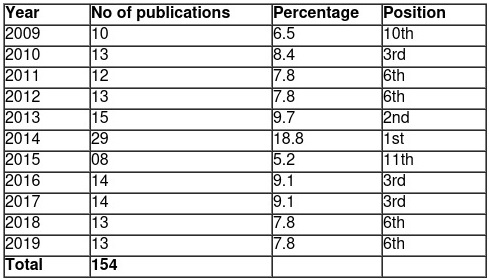
Table 4 shows the year-wise distribution of institutional repository publications in Emerald database. The year, 2014 had the highest publications with 29 (18.8%) followed by 2013 with 15 (9.7%). The rest are 2016 and 2019 at 14 (9.1%) respectively; 2010, 2012, 2018 and 2019 at 13 (7.8%); 2009 at 10 (7.8%). 2015 had the least number of publications at 8 (5.2%).
Table 5: Journal-wise distribution of institutional repository publications in Emerald by year
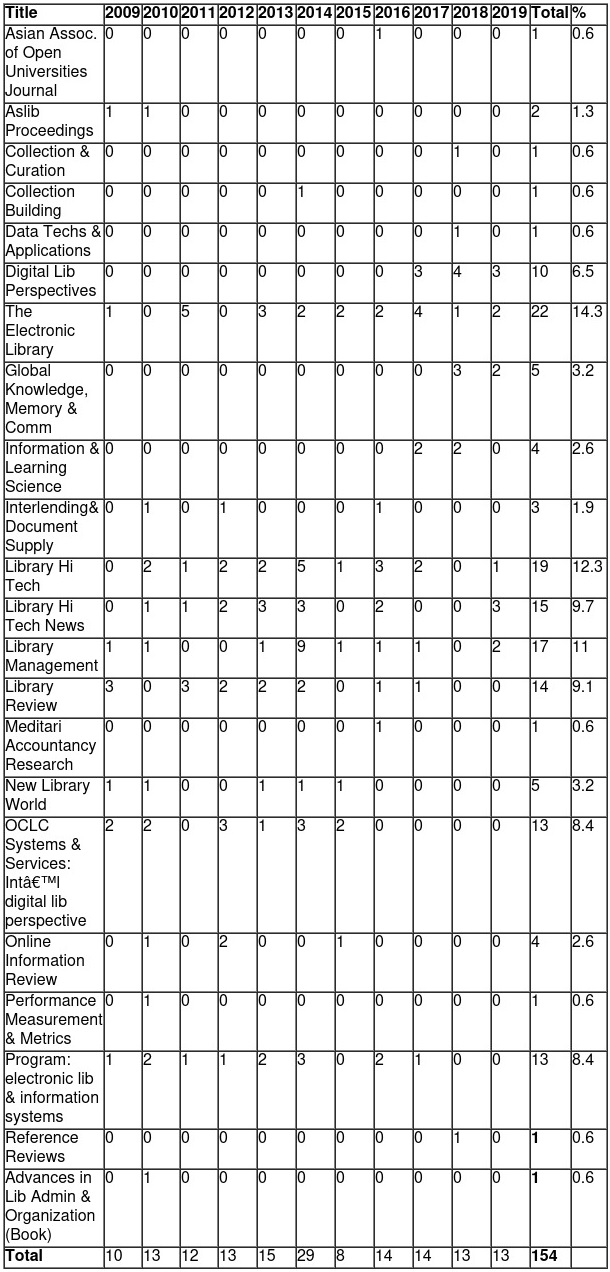
Table 5 shows the journal-wise distribution of publications. The institutional repository publications were altogether published in 21 journals and one book. There were 7 least published journals (Asian Association of Open Universities Journal,Collection & Curation, Collection Building, Data Technologies & Applications,Meditari Accountancy Research,Performance Measurement & Metrics,Reference Reviews) and a book (Advances in Library Administration & Organization) with 1 (0.6%) publication each. The Electronic Library took the lead as the highest on institutional repository with 22 (14.3%) publications, followed by Library Hi Tech at 19 (12.3%) and Library Management at 17 (11%). Other top 10 published journals include Library Hi Tech News, 15 (9.7%); Library Review at 14 (9.1%); OCLC Systems & Services: International digital library perspective and Program: electronic library and information systems at 13 (8.4%) respectively; Digital Library Perspectives at 10 (6.5%); and Global Knowledge, Memory and Communication and New Library World at 5 (3.2%) respectively.
Table 6: Category-wise distribution of Institutional Repository publications in Emerald by year
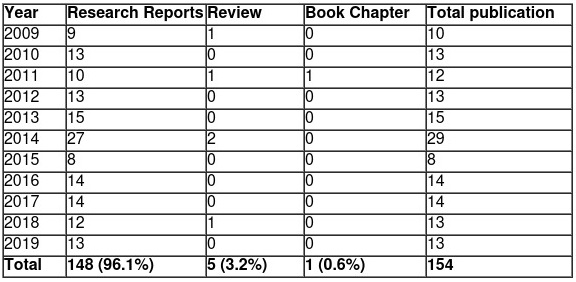
Table 6 shows the category-wise distribution of publications by year. All the publications in 2010, 2012, 2013, 2015, 2016, 2017 and 2019 were research reports. Reviews appeared in 2009, 2011, 2014 and 2018; while 2011 was the only year with a book chapter. In summary, research reports was the highest at 148 (96%), followed by Review at 5 (3%) and Book chapter at 1 (1%).
Table 7: Authorship Status and Collaboration patterns
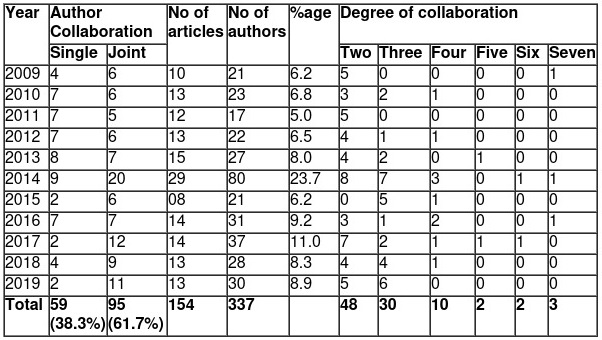
Table 7 shows the authorship status and collaboration pattern of institutional repository publications in Emerald database from 2009 to 2019. Of the publications, there were 59 (38.3%) single author publications and the remaining 95 (61.7%) publications had a total of 278 joint authors. 2014 has the highest author contribution with 80 (23.7%) authors writing 29 articles. This is followed by 2017 with 37 (11%) authors, 2016 with 31 (9.2%) and 2019 with 30 (8.9%). 2011 has the least with 17 (5%) authors contributing to 12 articles. Furthermore, joint collaboration pattern was highest in 2014 with 71 authors across 20 articles. Total author count is 337authors for the 154 institutional repository publications in Emerald database from 2009 to 2019. In determining the actual number of authors who published on institutional repository in Emerald database however, authors’ multiplicity was analysed, and this is shown in Table 8.
Table 8: Author’s Multiple Article Contributions to Determine Actual Author Number

Table 8 shows author’s multiple contributions. One (1) author contributed 5 articles, four (4) wrote 3 articles each, while eleven (11) contributed 2 articles each. Considering the authors multiple contributions, the actual number of authors who contributed institutional repository publications in Emerald is 305 authors.
Table 9: Collaboration patterns and interrelations of countries and institutions
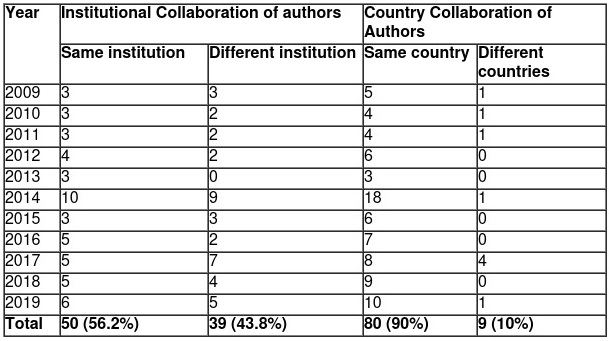
Table 9 indicates the collaboration patterns and interrelations of countries and Institutions. A total of 50 (56.2%) articles were written by collaborators from the same institution and 39 (43.8%) articles were authored by collaborators from different institutions. In the same vein, a total of 80 (90%) articles were authored by collaborators from the same country, while 9 (10%) were co-authored by collaborators from different countries.
Table 10: Most Published Author
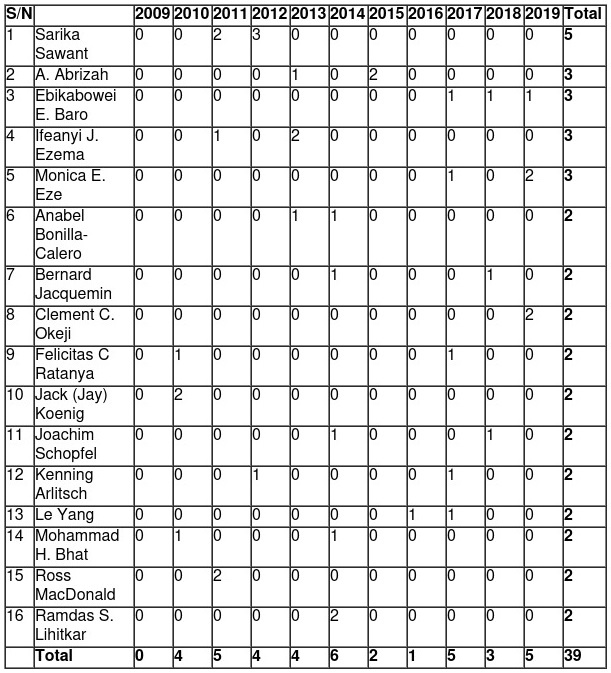
Table 10 lists the 16 authors that contributed more than one publication on institutional repository in Emerald database from 2009 to 2019. The most published author is Sarika Sawant with 5 articles. This is followed by 4 authors (A. Abrizah, E. E. Baro, I. J. Ezema and M. E. Eze) with 3 articles each, and 11 other authors (A. Bonilla-Calero, B. Jacquemin, C. C. Okeji, F. C. Ratanya, J. Koenig, J. Schopfel, K. Arlitsch, L. Yang, M. H. Bhat, R. MacDonald and R. S. Lihitkar) with 2 articles each.
Discussion
The study is a bibliometric analysis of institutional repository publications in emerald online database from 2009 to 2019. A total of 154 articles were retrieved from the database for the period under review. The institutional repository publications were altogether published in twenty-one (21) journals and one (1) book, with the Electronic Journal emerging as the most published journal on institutional repository in Emerald database.
Findings from the analysis also shows that the year 2014 had the highest institutional repository publications with 18.8% while 2015 had the least number of publications at 5.2%. On the type of article published on institutional repository in Emerald database, the study found out that 148 out of the 154 articles were research reports. Forty-five (45) countries published on institutional repositories in Emerald database. This is an indication that scholars across the globe adjudge the database reputable enough to publish their researches on institutional repositories. Of these countries, United States of America had the highest publications with 38 articles, followed by India with 24 articles and Nigeria with 13 articles. This is a step in the right direction for Nigerian librarians, as it shows that the country is not left out of current trends in the field.
The findings further revealed the twenty-two top six most published institutions with GERiiCO, University of Lille 3, Villeneuve d’Ascq, France taking the first position with 7 publications. Three institutions which include University of Nigeria, Nsukka, Nigeria took the 5th position with 3 publications each. The fact that these are mainly institutions in Africa shows that Africa is taking its pride of place in research on institutional repository. Researchers in developing countries have indeed recognized the importance of publishing papers in recent trends in the field, in reputable online databases.
Multiple contributions with one author having up to five (5) publications, four authors having up to three (3) publications respectively, and eleven (11) authors having two publications each, indicated a high regard for the database. The study discovered that 38.3% publications were written by single authors while 61.7% were joint authored. This agrees with a related study by Anyaoku and Okonkwo (2018) in which 56.1% were the output of collaborative writing as against 43% single authored articles.
The study found out that author collaboration was indeed high as up to seven authors collaborated in writing 3 articles respectively. Findings show an appreciable collaboration rate across institutions as 43.8%, of the joint authorship was from different institutions. The collaboration also extended beyond countries as 10% was collaboration across countries. These indicate a partnership that enables cross institutional and cross country sharing of best practices.
Conclusion
Institutional repositories have come to stay especially with the continued interest in open access scholarship. The study gives empirical evidence on institutional repository publications available in the Emerald database. The importance of Institutional Repository thus necessitated this bibliometric study to create awareness on studies carried out in this reputable and reputable online database.
References
Anyaoku, E. N. & Okonkwo, I. N. (2018). Publication pattern of Library and Information Science Digest journal: 2007 – 2016: a bibliometric analysis. Information Impact: Journal of Information and Knowledge Management, 9 (1), 68 -79. Retrieved from https://www.researchgate.net/publication/326966149
Bishop, L. (2007). Moving data into and out of an institutional repository: Off the map and into the territory. IASSIST Quarterly,31 (3-4), 13-20. Retrieved from https://iassistquarterly.com › index.php › iassist › article › view
Bluh, P. &Hepfer, C. eds, (2013). Foreword. The Institutional Repository: Benefits and Challenges. Document ID: ce09f8be-0f85-4b76-8cfd-73bde91b8ad7. Retrieved from http://www.ala.org/alcts/resources/papers/irs/intro
Clobridge, A. (2010). Building a Digital Repository Program with Limited Resources. Chandos Information Professional Series, 3-11. Retrieved from https://www.emeraldinsight.com › doi › PROG-08-2013-0044
Daniels, T. F., Jannik, C. M. & McDonald, R. H. (2005). Institutional Repositories: Issues and Challenges. Retrieved from https://smartech.gatech.edu › bitstream › handle › samm2005_5.04.05.pdf
Diaconu, S. (2019). ETH Library-Emerald. Retrieved from https://www.library.ethz.ch/en/Resources/Databases/Emerald
Gureev, V.N. &Mazov, N.A. (2015). Assessment of the Relevance of Journals in Research Libraries Using Bibliometrics (a Review). Scientific and Technical Information Processing 42, (30). Retrieved from https://doi.org/10.3103/S0147688215010050
Harinarayana, N.S. (n.d).Data Sources and Software Tools for Bibliometric Studies. Retrieved from https://epgp.inflibnet.ac.in/epgpdata/uploads/epgp_content/library_and_information_science/informetrics_&_scientometrics/data_sources_and_software_tools_for_bibliometric_studies/et/333_et_m2.pdf
Kannan, P. &Thanuskodi, S. (2019). Bibliometric Analysis of Library Philosophy and Practice: A study based on Scopus Database. Library Philosophy and Practice (e journal). 2300. Retrieved from https://digitalcommons.unl.edu/libphilprac/2300/
Lynch, C.A. (2003). Institutional Repositories: Essential Infrastructure for Scholarship in the Digital Age. Portal: Libraries and the Academy 3(2), 327-336. doi:10.1353/pla.2003.0039.
Ashikuzzaman, M. (2018). Brief Information about Institutional Repository. LIS BD Network: Library and Information Science Academic Blog. Retrieved from http://www.lisbdnet.com/brief-information-institutional-repository/
OECD Glossary of Statistical Terms (2013). Bibliometrics. Retrieved from https://stats.oecd.org/glossary/detail.asp?ID=198
Xie, Y., Ji, L., Zhang, B. & Huang, G. (2018). Evolution of the Scientific Literature on Input–Output Analysis: A Bibliometric Analysis of 1990–2017. Sustainability, 10, 3135.doi:10.3390/su10093135. Retrieved from www.mdpi.com/journal/sustainability.